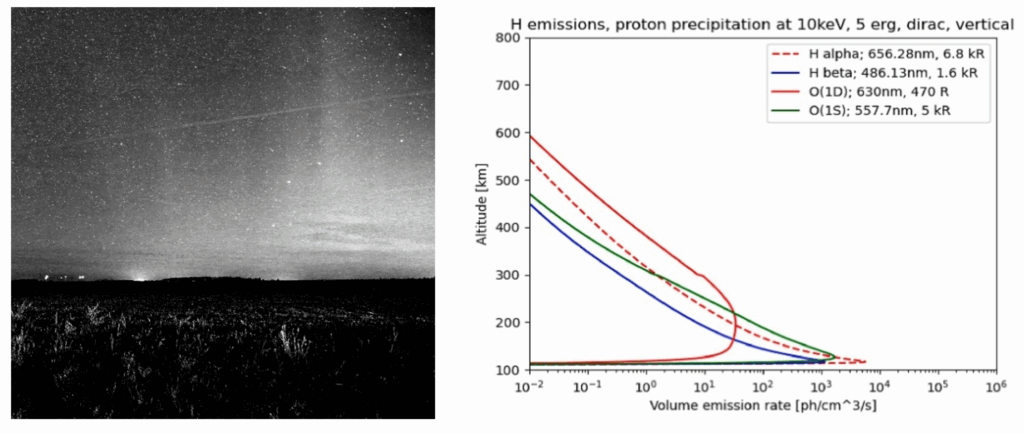Red or even green aurorae observations at mid-latitudes are rare but not exceptional. However, while high-latitude sightings of blue aurorae are frequent, sighting at mid-latitudes have rarely been reported. During the night of September 24–25, 2023, an unexpected blue aurora was observed from a viewpoint at only 48.3° geographic north (49.88°N in geomagnetic coordinates), in France by a member of the MATRIX group. While the excitation mechanism of red or even green aurorae are understood, the origin of such a high elevated blue aurora is more difficult to determine.
The absence of atomic oxygen emission line at 557.7 nm (green) above this blue aurora excludes the classical electron precipitation mechanism. In such mechanism, the blue emission at 427.8 nm from the N2+ first negative band (B2Σu+→X2Σg+) is present at lower altitude than the 557.7 nm emission of the atomic oxygen quoted above, which is not the case here (Figure left). We also exclude the less common mechanism of proton precipitation. First, our transport models show that the atomic oxygen lines and the Ha Balmer emission line at 656.3 nm would have been seen too, whatever the incident energy of the protons. Second, the Hβ Balmer emission line at 486.1 nm would have partially been detected in the green channel too, because of the overlapping of the RGB filters on CMOS ships. Our kinetic electron transport code shows that the excitation of the Vegard-Kaplan and first positive bands of neutral N2 by low energy electrons cannot account for the lack of red and green colors too, although they cannot be fully ruled out (Figure right).
Our conclusion is that a resonant scattering phenomenon is the most likely explanation. In this process, direct solar light enhances the emission of N2+ first negative band, at ionospheric F-region heights, while it’s still night at ground level. However, the mechanism by which N2+ are uplifted to such a high-altitude region of the atmosphere, is still to be clarified. This work was recently released in Journal of Space Weather and Space Climate.

Figure. (left) Pillars of the aurora (most visible in the left part of the image), in the blue channel of a 6D Canon camera equipped with a 1.4/20mm lens. Exposure time is 20 seconds at f/2.2. (right) Production of the Balmer Hβ (blue line) and Hα (dashed red) emissions due to 5 erg proton precipitation. The blue Hb line is overtaken by atomic oxygen emission, whatever the altitude.
Reference
Emmanuel Beaudoin et al., A rare observation from mid-latitude of a blue aurora, J. Space Weather Space Clim. (2025), 15, 16.
DOI: 10.1051/swsc/2025012
Contact : Emmanuel Beaudoin
